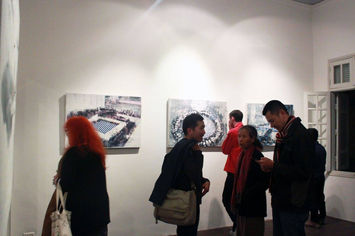
Lam
-
January 11, 2016
December 12, 2015
Lê Quý Tông
'True Blue' - marking Le Quy Tong's return after 7 years - is the result of years of working in silence and marks a clear departure from the artist’s previous interest. Tong last exhibited in 2008, and has since been experimenting with new techniques and themes previously absent from his practice, making each research an inquiry into fine art's most traditional medium - painting. The resulting body of work thus announces more than just a comeback; it marks a revitalizing chapter in Tong's practice and fortifies his position as one of Hanoi’s most dedicated and resilient creative forces.
True Blue sees Le Quy Tong experiment with a hybrid of painting, decorated pattern and found imagery. Each of the works takes its starting point from photographic documentations of significant political meetings that influenced the course of history. The images - sourced from historical archives and mass media - have been taken out of their original contexts and appropriated, dissected and reassembled into something new and uncanny, making it difficult to decipher between the make-believe, the manipulated and the genuine. Together, they highlight the generic features of all meetings - big halls filled with hefty chairs, grand tables and elaborate chandeliers; men deep in discussion or signing papers. An air of ceremony lingers even when all content and context are stripped away.
Once a photograph found its way onto the artist’s canvas, he employed a number of editing devices such us pixilating, blurring and pattern overlaying. Each of the gloomy, cool and blue-colored finished collages is the accumulation of countless layers of paint, visual motif and imagery, which have been applied, erased, smoothened, scratched and piled on top of each other. Displayed together, they provoke a sense of glamorous nostalgia and contribute to a distinctively elegant style and rhythm, reinforced by a shared perspective, composition and treatment of paint and imagery.
As figures and shadows sink and rise, visual cues disappear and become, textures, forms and colors part and merge, recognisable events and times in history are rendered an illusion. But what seems to be specific could allude to any place and any time in any history. Déja vu! What appears before us is familiar to the eyes, yet the mind cannot identify why. Have we seen these imageries before? What do we see when we look at a singular photographic depiction of an event? What about the missing people, voices and actions in history that existed outside the realm of a single frame and evidence?
The construction of history and memory, or rather the construction of history and memory through photographic documentation, is called into question, and its limitations are revealed. Is the blurred meant to be forgotten, or hidden? Do the overlays introduce alternative narratives, or sugarcoat darker ones? Does the pixilation highlight individual elements, or obscure something and dismantle the whole? What happens when an image is used in a place and time other than where and when it was intended for? What does this act of displacement do to the final works? Does it inform our knowledge and reinforce our trust in photographic documentation? Or does it lay bare the ability to use it to tell lies, falsify reality and shape our perception with seeming evidence?
With his systematic, yet intuitive, ordered but open-ended, labour-intensive methodology, Le Quy Tong presents us with an alternative space to engage with the real and the imagined, the authentic and the fabricated, by erasing the illusive borders that separate them. The blue color palette which connects all the series’ pieces evokes a deeply sad and unsettling atmosphere, which reflects the mood at the basis of the work. The color also stands for loyalty and a commitment to truth – a perfect contrast to the deceptive nature of those concepts as revealed in True Blue.
ARTWORKS
GALLERY
OPENING NIGHT
















